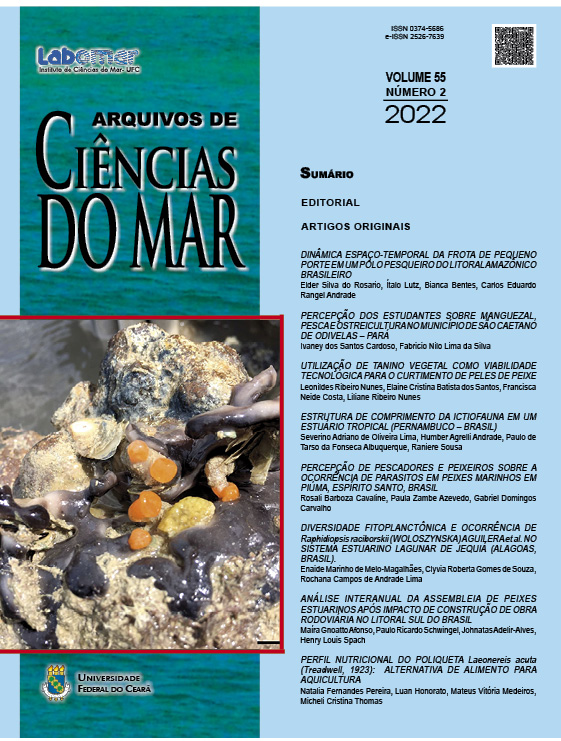Characterization of microplastics found in the intertidal zones of Jericoacoara National Park, Ceará, Brazil
DOI:
https://doi.org/10.32360/acmar.v55i2.77950Abstract
The present work evaluated the presence of microplastics at three points in the Parna de Jericoacoara, analyzing the beach sediment and four benthic species of sandstone reefs: the bivalve Brachidontes exustus, the gastropods Stramonita brasiliensis and Lottia subrugosa and the barnacles Chthamalus bisinuatus. The results obtained showed concentrations of microplastics, classified into fragments, fibers and pellets, from products for human use. Fragments were the most abundant polymers in the study and showed color diversity. Fiber was the only class found at all collection points and pellets were the least abundant in the study. It was also a black colored fiber in B. exustus and a blue colored fiber in C. bisinuatus. Fiffy-three point ninety-two percent of the microplastics found in the sediment had dimensions smaller than 1 mm. The data obtained in the present work indicate that microplastics are present in the beach area and in suspensory animals of Jericoacoara, requiring management and environmental education measures to help in the conservation of the Parna.
Keywords: environmental impact, beach, conservation unit.
Downloads
Published
Issue
Section
License
Copyright (c) 2023 Arquivos de Ciências do Mar

This work is licensed under a Creative Commons Attribution 4.0 International License.
1. Proposta de Política para Periódicos de Acesso Livre
Autores que publicam nesta revista concordam com os seguintes termos:
- Autores mantém os direitos autorais e concedem à revista o direito de primeira publicação, com o trabalho simultaneamente licenciado sob a Licença Creative Commons Attribution que permite o compartilhamento do trabalho com reconhecimento da autoria e publicação inicial nesta revista.
- Autores têm autorização para assumir contratos adicionais separadamente, para distribuição não-exclusiva da versão do trabalho publicada nesta revista (ex.: publicar em repositório institucional ou como capítulo de livro), com reconhecimento de autoria e publicação inicial nesta revista.
- Autores têm permissão e são estimulados a publicar e distribuir seu trabalho online (ex.: em repositórios institucionais ou na sua página pessoal) a qualquer ponto antes ou durante o processo editorial, já que isso pode gerar alterações produtivas, bem como aumentar o impacto e a citação do trabalho publicado (Veja O Efeito do Acesso Livre).

